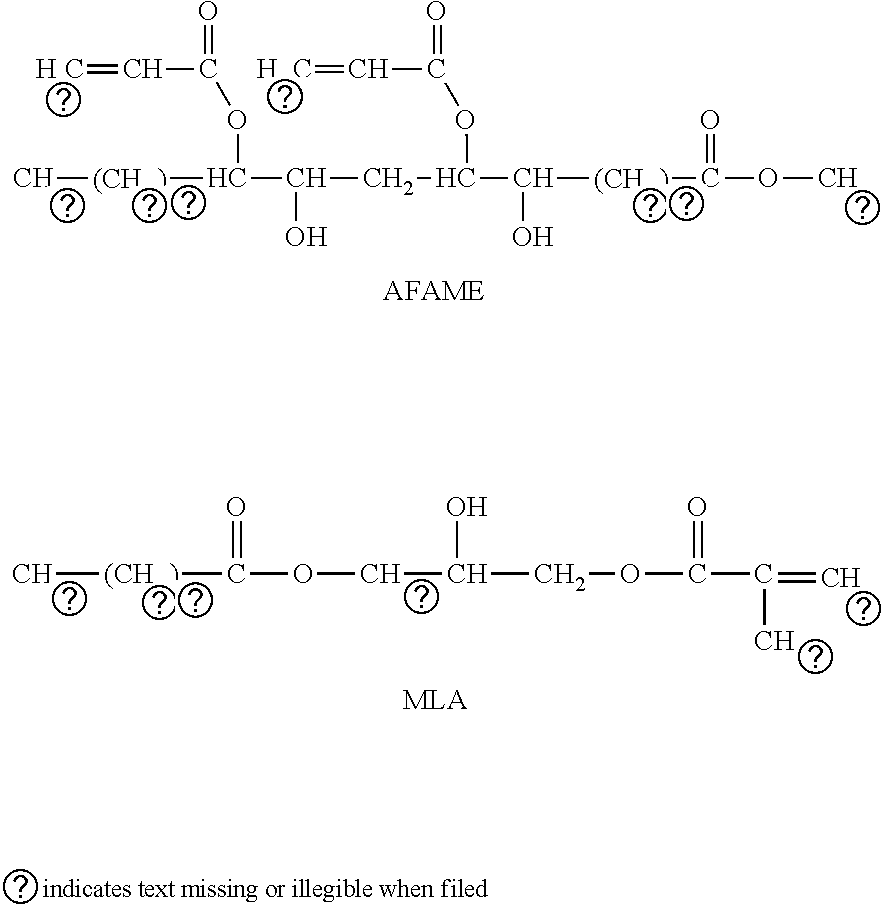Composites having leather-like characteristics
a technology of composite materials and leather, applied in the field of biobased materials, can solve the problems of imposing limitations on the level of volatile organic compound emissions for all industries, increasing the cost of producing tanned leather in the united states, and 200 pounds of solid waste, and achieve the effect of permeable and breathabl
- Summary
- Abstract
- Description
- Claims
- Application Information
AI Technical Summary
Benefits of technology
Problems solved by technology
Method used
Image
Examples
example 1
Material: AESO / MLAU (50 / 50)+47 wt % Washed Linen Fiber
[0036]This example utilized a resin which is composed of 50% AESO (acrylated epoxidized soy oil) and 50% MLAU, which is a functionalized softening fatty acid (methacrylated lauric acid). The composite was made with 53 wt % of this resin combined with 47 wt % of the washed linen fibers. These fibers exhibited good wetting properties with this resin. The fibers by themselves have a modulus of elasticity E=0.2 GPa, which can be considered low for natural fibers, but their tensile strength σ=16 MPa is consistent with leather properties. The composite properties are considered to be good and suited to use as a soft leather: The modulus of elasticity is E=0.089 GPa or 89 MPa. The tensile strength of 12.7 MPa is also within the target leather range. The strain at break is quite respectable also.
example 2
Material: AESO / MLAU (50-50)+54 wt % Brown Flax Fiber
[0037]The fiber by itself is stiff with E=1 GPa and tensile strength of 40 MPa, which is better than most leathers. The fiber is very compatible with the resin and this impacts positively on the composite properties. The composite properties are excellent with 54 wt % fiber giving a modulus of 1.7 GPa, which is quite stiff, and the tensile strength is 65 MPa. Note that despite the addition of a softer resin, both of the composite properties exceed that of the bare fibers, which is most unusual but can be understood in terms of the compatibility of the resin with the fibers. The resin is soaked up by the fibers and improves the fibers basic properties.
[0038]Composition: 54 wt % fiber; 1 layer
[0039]Properties: very flexible, semipermeable, water repellant.
example 3
Material: AESO / MLAU (70-30)+51 wt % Brown Flax Fiber
[0040]This composite has a higher AESO content compared to the material of Example 2, but the properties are comparable to a stiff leather material.
[0041]Properties: flexible, semipermeable, water repellant.
[0042]Composition: 1 layer, 51 wt % fiber.
PUM
| Property | Measurement | Unit |
|---|---|---|
| Pressure | aaaaa | aaaaa |
| Pressure | aaaaa | aaaaa |
| Pressure | aaaaa | aaaaa |
Abstract
Description
Claims
Application Information
 Login to View More
Login to View More - R&D
- Intellectual Property
- Life Sciences
- Materials
- Tech Scout
- Unparalleled Data Quality
- Higher Quality Content
- 60% Fewer Hallucinations
Browse by: Latest US Patents, China's latest patents, Technical Efficacy Thesaurus, Application Domain, Technology Topic, Popular Technical Reports.
© 2025 PatSnap. All rights reserved.Legal|Privacy policy|Modern Slavery Act Transparency Statement|Sitemap|About US| Contact US: help@patsnap.com



